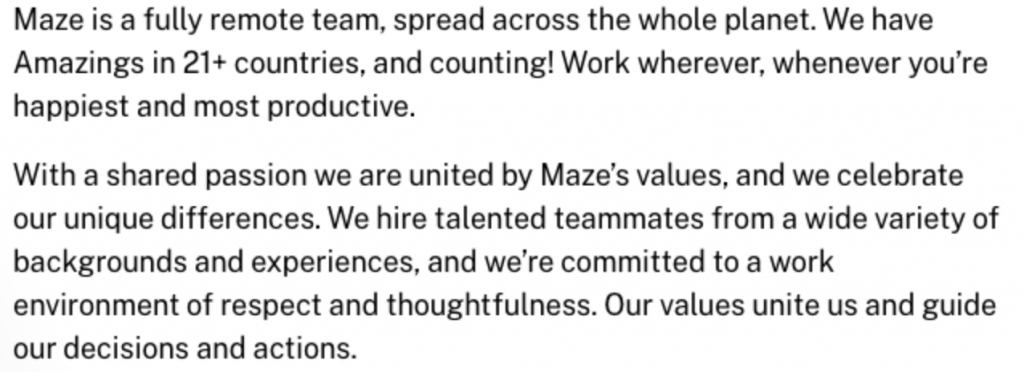Best Practices for Diverse Sourcing, and How to Remove Bottlenecks in Your Hiring Process — by Stephanie Garza of Maze

Sourcing is the key in the hiring process, as it helps the recruiter to find relevant information about the right candidates with experience and skills a company needs. With sourcing, it’s easier to identify if the candidate is actively looking for a job or not.
At first, sourcing may seem like a very overwhelming and complicated process. However, it can be easy and effective if you use the right tools and techniques.
In this new entry to our Guide for Building and Scaling Sourcing in Fast-Paced Organizations, you will learn about how to make the sourcing process more effective. Stephanie Garza from Maze walked us through the hiring process at Maze and shared which tools the recruitment team uses for sourcing.
Maze is a Series A funded start-up experiencing a tremendous amount of growth. Leaders are building strategies to ensure we build a hiring plan that fits the needs of every department. The team has devoted a lot of time to developing an inclusive hiring process.
 Stephanie is a Talent Acquisition Partner with more than 5 years of experience in recruitment. She served as a Recruiter and Sourcing Specialist for companies, such as PowerToFly, GitLab, and States Title. At Maze, Stephanie works directly with the CTO helping to build out the Engineering team through full-cycle recruitment.
Stephanie is a Talent Acquisition Partner with more than 5 years of experience in recruitment. She served as a Recruiter and Sourcing Specialist for companies, such as PowerToFly, GitLab, and States Title. At Maze, Stephanie works directly with the CTO helping to build out the Engineering team through full-cycle recruitment.
If you want to learn more about the sourcing and hiring process, Stephanie is the right person to guide you.
How Maze’s Recruiting Team works
At Maze, there are two Full Cycle Recruiters — one EMEA-based and another US-based. There is also one Diversity Sourcer. The hiring process at Maze includes:
- Recruiter Screen
- Hiring Manager Interview
- Technical Assessment (varies by team)
- Executive final (45 min)
- Reference Check
To successfully complete each step, Maze’s recruiting team uses the following sourcing tools:
- Cord.co. This is the invite-only messaging tool, which gives job seekers direct access to hiring teams in tech companies across Europe. This platform makes it easy to communicate with hiring managers, as people can send them messages in just two clicks. Cord simplifies the communication between recruiter and candidate, making the sourcing process faster.
- Linkedin Recruiter. It’s a hiring platform, where you can access a huge network of candidates and contact them directly through InMain, LinkedIn’s messenger. You can work in teams and easily share searches, profiles, etc. Via LinkedIn Recruiter you can find many great candidates from different fields, not only tech. The only disadvantage is that it’s hard to find passive candidates on the platform.
- AngelList. This is a website for startups, angel investors, and people who want to work for a startup. Candidates can apply privately to different tech and startup jobs with one application. However, there is low engagement on the website, meaning lower chances to find a good candidate.
- Circular. It’s a private community, where startups can share information about candidates that they already interviewed, and loved, but who weren’t the exact fit for the company. Circular provides a fast and GDPR-compliant way of matching qualified candidates with other job opportunities in the community.
- Karat. Stephanie says, “Growing the engineering team is a priority, so we have partnered with Karat to assist with Technical interviews as well as explored a lot of different sourcing platforms.” Karat takes on the process of technical interviewing by connecting already sourced candidates with live engineers to interview, test, and evaluate the candidates for the next step of the recruitment process
What could be better with modern sourcing
Unfortunately, a big issue in sourcing is that the diversity sourcing numbers are lower than desired and recruiters should always address the issue and do their bit to improve the situation.
Diversity sourcing is significant as it ensures the inclusion and representation of minorities in the company. The benefits of inclusiveness and diversity in the workplace include increased trust among employees, a better environment for innovation, improved employee performance, and many more.
How to approach Diversity Sourcing
There are three main aspects that recruiters at Maze take into consideration during diversity sourcing. These include:
Diversity Branding
During diversity branding, the company must use different communication channels to pass the right message to the audience. Here is what to focus on in diversity branding:
- Building up the diversity content of the Careers page. Here is an example of Maze Career page content that promotes diversity:
- Using social media to spread the word about diversity efforts. You need to use social media channels to show your voice and prove your credibility. Through social media, you can share what your company does to ensure diversity, so more people know about it.
- Updating print materials to embody a diversified company. Print materials still play a huge role in creating a good first impression about the company. Make sure print materials also emphasize the company’s values, where diversity is one of the most important. They are not very relevant in the Covid era, however, if you do anything offline at the moment, make sure your promo materials are diverse.
Use Keywords to Source for Diverse Candidates
Keywords may help recruiters to narrow their search and find the perfect candidates that qualify for the position. You should pay close attention to the following aspects:
- Choosing the right keywords to maximize diversity sourcing efforts. You can build them into your recruiter search strings to narrow down which kind of applicants you want to connect with. For example, if you want to attract female candidates, add professional women’s organizations and schools to your keyword search like “American Business Women’s Association.” To find minority candidates you could add, “LGBT in higher ed,” or, “Blacks in higher ed,” and so on.
- Joining diverse groups on LinkedIn. This will help you to build relationships with diverse candidates. After establishing a relationship, you can start to post relevant jobs to the groups that are relevant and closely match the target demographic.
- Establishing contact with school campus groups such as sororities, organizations, and clubs that embody/promote diversity. Through LinkedIn, recruiters can build a legitimate and professional relationship with academic groups. Having these connections opens up many opportunities for collaboration. It could be in the form of directly recruiting individuals, offering your company to assist with school initiatives or simply gaining exposure and influence to a diverse audience.
Breed a culture of diversity
Creating a diverse company culture is crucial for every business, as it’s affecting all aspects of the company, including sourcing and hiring new employees. Through training, good leadership, and additional efforts you can build a positive culture, where employees will prosper and do their bit in inclusion efforts.
- Diversity training. With good training, you can teach current employees how to embrace diversity through inclusion efforts. Team dynamic exercises are critical for developing a culture of diversity.
- Tracking. Recruiters should track information, such as job descriptions, resume screenings, and performance reviews, as they are being created, to detect biased wording or any biases that are irrelevant to whether or not the person being reviewed can do the job.
- Leadership. When implementing diversity efforts, the company’s leadership must reinforce them. It will make the process more effective, as leaders communicate the company’s mission and values to their employees.
Conclusions
These tools and tips will help to make your recruitment team much more productive. The main secret to success in sourcing is using the right software with the needed tools to identify the perfect candidate. Without proper tools, the sourcing process will be more difficult and time-consuming.
 Finding this article insightful?
Top Recruiters create content for AmazingHiring.
Subscribe to receive 1 curated newsletter per month with our latest blog posts.
Finding this article insightful?
Top Recruiters create content for AmazingHiring.
Subscribe to receive 1 curated newsletter per month with our latest blog posts.

80% of Tech candidates are passive.
Level up your outbound sourcing strategy.This article is a part of our Guide for Building and Scaling Sourcing in Fast-Paced Organizations. We’ve already covered “The first signs you need a sourcing team” and “In-house vs. Agency” topics. Check those out! We’ve invited James Mottram, Lead talent acquisition and research partner at Elements Talent Consultancy, currently embedded at Monzo Bank, to […]
With this interview, we are expanding our Guide for Building and Scaling Sourcing in Fast-Paced Organizations. You may find other entries to this guide in our blog. GitLab builds software to help others build software. Their best practices in fulfilling recruitment requirements apply to any fast-paced organization searching for tech talent. That is why today […]
Disclaimer: The article is created based on materials provided by Yves Greijn, Lead Engineering Sourcer (ex-QuantumBlack, now Miro), Neha Naik, CEO of recruitgyan.com, and Monika Nemcova (AIHR, ex-Content Marketer from harver.com) How do you measure your recruiting success? We have prepared an ultimate list of recruiting & sourcing metrics to be checked regularly. All metrics formulas can […]







